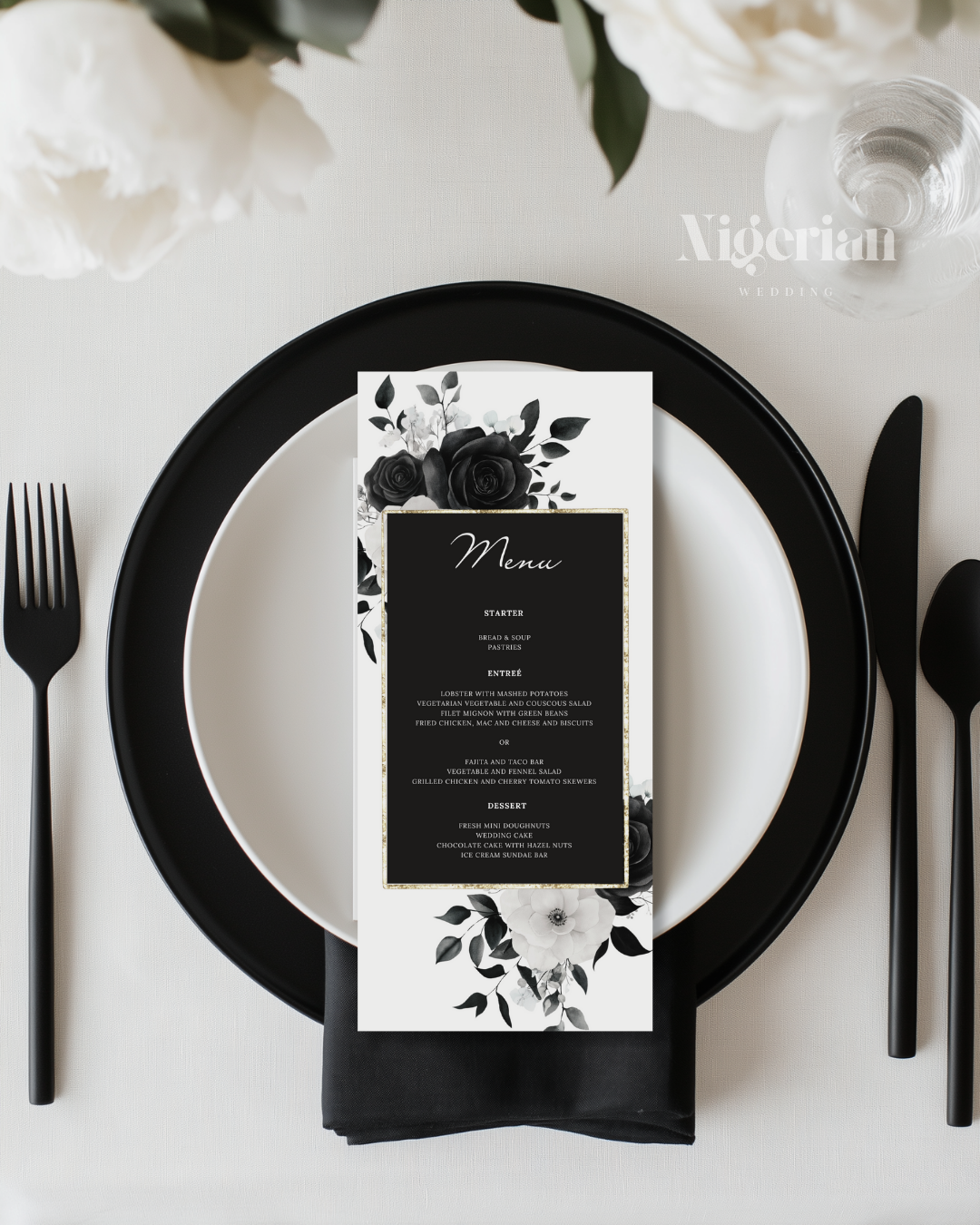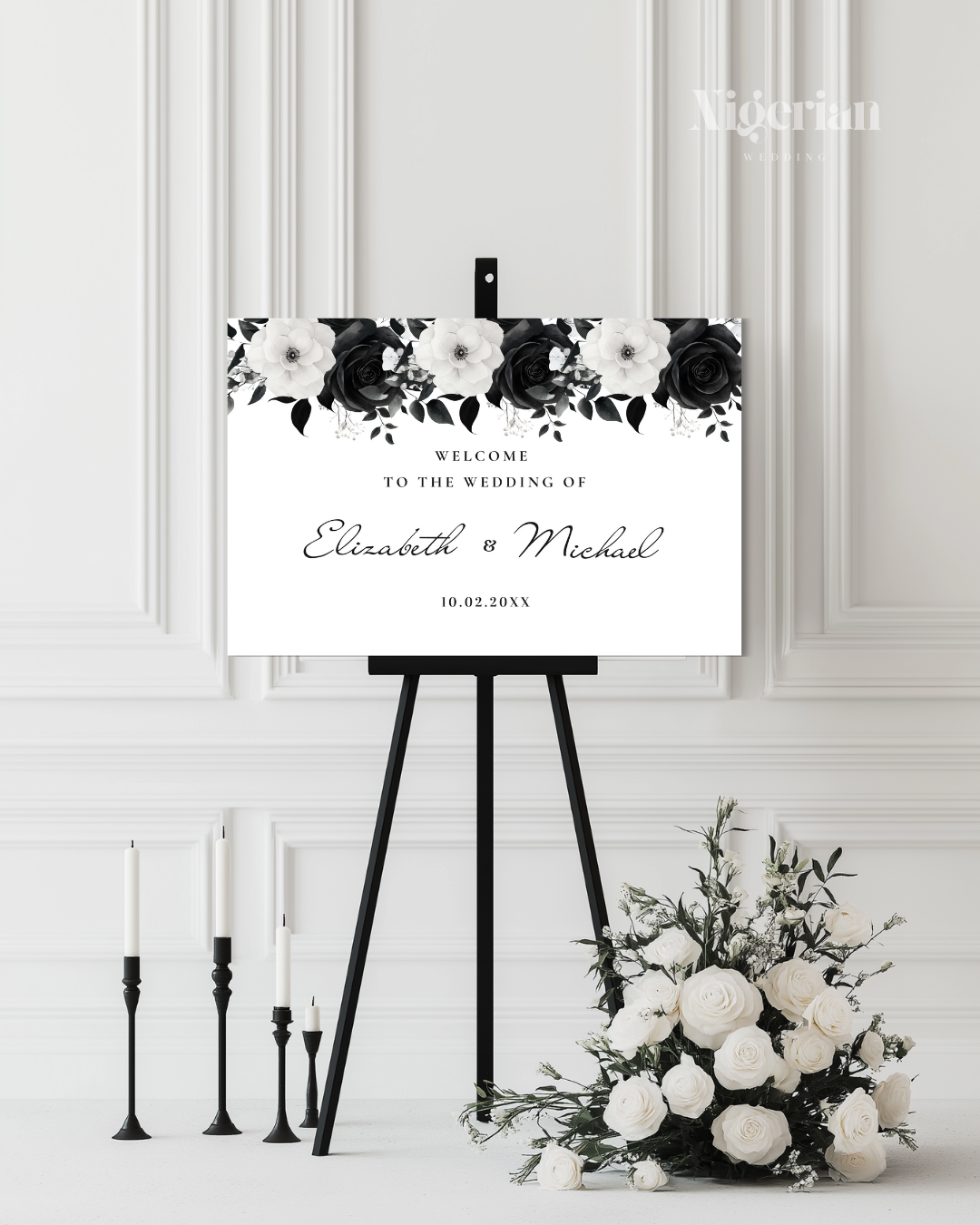Ultimate Guide to Wedding Menu Stationery! Wedding menu stationery is a vital part of your wedding decor, as it not only informs your guests of the delicious food they’ll be served but also reinforces the style and theme of your celebration. When planning a Nigerian wedding, food is at the heart of the celebration, making the wedding menu stationery even more important. It’s the perfect way to introduce guests to the rich cultural delicacies they’ll enjoy while maintaining an elegant and cohesive look that reflects your wedding style.
In this post, we’ll explore the various aspects of designing Wedding Menu Stationery, including how to organize your menu, what elements to include, and how to craft the perfect wording. Using a Nigerian menu as an example, we’ll also highlight popular dishes and how to creatively incorporate them into your wedding stationery.
1. Why Wedding Menu Stationery is Essential
Wedding menu stationery serves several important purposes. Beyond simply listing the food, it adds a personalized and elegant touch to each guest’s dining experience. Here’s why it’s an essential component of your wedding planning:
a) Sets Expectations
Your menu provides guests with a preview of the culinary experience they’re about to enjoy, whether it’s a sit-down dinner or a buffet. Guests with dietary preferences or allergies can also use the menu to know what’s available to them.
b) Enhances the Table Decor
Menu cards can be designed to complement the overall aesthetic of your wedding. Whether you’re having a minimalist wedding or a more elaborate event, the stationery should match your color scheme, theme, and decor.
c) Elevates the Guest Experience
A well-designed menu adds an air of sophistication to the dining experience. It also shows that you’ve carefully curated your food choices to reflect both your culture and your personal taste.
2. Designing Your Wedding Menu Stationery
Designing the perfect wedding menu involves a mix of aesthetics and practicality. From font choices to layout, everything should be harmonious and functional. Below are the critical factors to consider when creating your Nigerian-inspired wedding menu:
a) Choose a Design that Matches Your Wedding Theme
Your wedding menu should visually align with your overall wedding theme. If you’re hosting a traditional Nigerian wedding, you might opt for vibrant colors, traditional patterns, or cultural symbols. For a more modern wedding, minimalist designs with sleek typography may work better.
- Material Choices: Consider using high-quality paper, vellum, or even acrylic for a modern touch. Wooden menu cards are great for rustic or outdoor weddings.
- Incorporate Nigerian Patterns: Adire prints, Ankara designs, or traditional Nigerian motifs can be incorporated into the design for a cultural flair.
b) Font and Typography
When selecting fonts for your wedding menu, ensure they are easy to read and suit the tone of your wedding. Script fonts are more romantic and formal, while serif fonts give a modern and clean look.
- Tip: Use bold headings for the course titles and a simpler, more readable font for the dish descriptions.
c) Menu Format
Menus can be presented in different formats depending on your wedding style and the dining arrangement:
- Individual Menu Cards: Ideal for plated dinners or formal receptions. Each guest receives a menu at their place setting.
- Table Menus: One or two menus placed on each table can work for more casual or buffet-style receptions.
- Display Board Menus: Large, decorative boards listing the menu are perfect for buffet settings or large weddings with a central dining area.
3. Organizing Your Wedding Menu
Your menu should be structured in a clear and logical manner, making it easy for guests to follow. Here’s how to organize your Nigerian wedding menu:
a) Introduction
Begin your menu with a welcoming note or introduction, such as:
- “Welcome to Our Wedding: We’ve curated a selection of our favorite dishes, blending traditional flavors with modern twists. Enjoy!”
b) Course-by-Course Breakdown
Typically, a wedding menu is divided into several courses. Here’s how you can structure each section:
- Appetizers (Small Chops) Nigerians love “small chops” (appetizers) at weddings, and these can be listed as part of the first course. Popular options include:
- Puff-Puff: Fluffy fried dough balls, lightly sweetened.
- Samosa: Crispy pastry filled with spiced vegetables or meat.
- Spring Rolls: Deep-fried rolls with a savory filling of veggies or shrimp.
- Main Course For the main course, Nigerian weddings often feature a variety of rich and flavorful dishes. Be sure to list any signature items. Some common options include:
- Jollof Rice: A West African staple, slow-cooked with tomatoes, peppers, and spices.
- Pounded Yam with Egusi Soup: Yam served with a thick, hearty melon seed soup.
- Fried Rice: Flavored rice mixed with vegetables, shrimp, and chicken.
- Grilled Fish or Meat: Charcoal-grilled tilapia or goat meat, served with spicy pepper sauce.
- Side Dishes Side dishes are equally important in Nigerian weddings and often include:
- Moi Moi: Steamed bean pudding made from ground peeled beans, onions, and peppers.
- Plantains: Fried ripe plantains, sweet and crispy on the outside.
- Coleslaw: Freshly shredded cabbage and carrots in a creamy dressing.
- Desserts For dessert, you might include local and international treats:
- Chin Chin: Fried dough snacks, crunchy and sweet.
- Fruit Salad: A refreshing mix of seasonal tropical fruits.
- Beverages Beverage options are often diverse and can include traditional Nigerian drinks alongside more common refreshments:
- Chapman: A Nigerian favorite, made with Fanta, Sprite, Angostura bitters, and grenadine.
- Palm Wine: A sweet, slightly alcoholic beverage from the sap of palm trees.
4. Crafting the Perfect Wording for Your Menu
The wording of your wedding menu should reflect the style of your wedding. Here are some tips to guide you:
a) Use Descriptive Language
Make sure to describe each dish in a way that entices your guests. For example, instead of just listing “Jollof Rice,” you could write:
- “Jollof Rice: A rich, tomato-based rice dish with a perfect blend of West African spices.”
b) Personalize It
Add a touch of personality to your menu by including short descriptions or notes about the dishes. For instance:
- “Our signature Jollof Rice recipe has been passed down through generations—this is a dish you won’t want to miss!”
c) Keep It Clear and Concise
While it’s important to be descriptive, avoid making the menu too long or complicated. Stick to brief but engaging descriptions.
d) Wording Examples for a Nigerian Wedding Menu
Below is a sample of how a Nigerian wedding menu could be worded on your stationery:
Welcome to the Feast!
We are thrilled to share some of our favorite dishes with you, blending rich Nigerian flavors with modern influences. Bon appétit!
Small Chops:
- Puff-Puff: Light, fluffy fried dough balls.
- Samosa: Crispy pastry filled with savory vegetables or beef.
- Spring Rolls: Golden fried rolls with vegetables or shrimp filling.
Main Course:
- Jollof Rice: Flavored with tomatoes, peppers, and a blend of West African spices.
- Pounded Yam with Egusi Soup: Smooth pounded yam served with a rich melon seed soup.
- Fried Rice: Nigerian-style fried rice, mixed with shrimp, chicken, and vegetables.
- Grilled Tilapia: Charcoal-grilled tilapia served with a spicy pepper sauce.
Side Dishes:
- Moi Moi: Steamed bean pudding, seasoned to perfection.
- Fried Plantains: Sweet and crispy plantains, fried golden brown.
- Coleslaw: Fresh and crunchy, with a creamy dressing.
Desserts:
- Chin Chin: Sweet, crunchy fried dough snacks.
- Tropical Fruit Salad: A refreshing mix of pineapple, mango, and watermelon.
Drinks:
- Chapman: A Nigerian classic, fruity and refreshing.
- Palm Wine: A traditional sweet and slightly alcoholic drink.
5. Final Tips for Creating Stunning Wedding Menu Stationery
To ensure your wedding menu stationery is both functional and beautiful, here are a few final tips:
a) Work with a Professional Designer
Hiring a professional stationery designer ensures that your menus are tailored to your theme, visually appealing, and printed on high-quality materials.
b) Proofread Thoroughly
Double-check for any spelling mistakes or inaccuracies in the food descriptions. It’s important to make sure your menu represents the dishes accurately.
c) Personalize the Design
If you want your menu to stand out, consider adding custom illustrations, such as images of the dishes or cultural symbols that reflect your heritage.
d) Coordinate with Your Other Wedding Stationery
Your wedding menu should be consistent with your other stationery, such as invitations, table numbers, and place cards. This will create a cohesive look throughout your wedding.
6. Conclusion
Wedding Menu Stationery plays an integral role in creating a memorable dining experience for your guests. From presenting delicious dishes to enhancing your table decor, a thoughtfully designed menu showcases your attention to detail and reflects your unique wedding style. Whether you’re serving a traditional Nigerian feast or blending cultural flavors with modern cuisine, your menu should speak to your heritage, taste, and wedding vision.
















